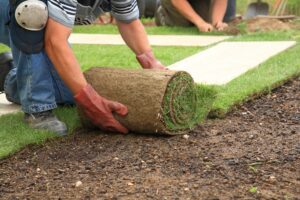
Laying sod can be easy when you remember these tips.
The importance of laying sod is that you can use it in an area where seed would be too expensive to use or where it would blow away. Also, sod prevents soil erosion and helps air and water quality while aiding flood prevention. Sod is valuable to use at any time during the growing season. However, it’s most effective during spring and fall while the temperature is moderate. Rainy weather also helps the sod to root quickly. If you’re a beginner at laying sod, you’ll want to follow these tips because sod is a hefty investment.
Step One Before Laying Sod: Soil Preparation
We advise that you remove twigs, stones, and other debris to prep the soil before laying down sod. It also helps to do a soil test beforehand to understand your lawn’s condition. If your soil has a low pH, add one of the three following:
- Lime
- Dolomite limestone
- Wood ashes
If your lawn has a high pH, add one of the following:
- Horticultural sulfur
- Composted oak leaves
- Pine needles
Step Two: Fill Your Lawn with Top Soil
Next, we suggest breaking up soil clods larger than two inches in diameter. Fill void areas with high-quality topsoil. If you have sandy soil or soil that’s full of clay, work in organic matter. Use this time to improve the soil quality. It’s easier to enhance a lawn when it’s stripped down or bare.
Step Three: Make the Soil Smooth
You can use a stiff garden rake to smooth the soil. Evenly distribute any soil bumps or piles to create a flat area. Then, you can finish preparing the lawn by using a lawn roller.
Step Four: Laying Sod
The goal is to minimize plant stress. Therefore, you should lay sod on an overcast day when the sun isn’t shining so much. If hot weather is unavoidable, ensure that you moisten the area before applying sod. Stagger the strips in a brick-like pattern and secure the sod so that each piece fits together. If you’re placing the sod in an irregular area, a utility knife or sharp spade is handy to cut the sod into odd shapes. Once the sod is in place, run the sod roller over it to eliminate air pockets.
Step Five: Watering the Sod
After successfully laying sod, you should water it immediately. Afterward, like grass, water your sod daily. Moisten the sod to the depth of 4 inches until the sod takes root, which typically occurs in two to three weeks. You can tell if sod has roots by gently tugging at it. If you feel any resistance, anchored roots are in the underlying soil.
Choose Edward’s Lawn & Home
For the past thirteen years, Edwards Lawn and Home has been offering premier residential and commercial services to improve your property all year long. The options are endless from a new patio to a backyard fire pit, let the winners of Angie’s List Super Service Aware serve you! If you’re interested in finding out more about our services or getting a quote, you can contact us online or give us a call at 443-341-6539. For more information about our services or DIY tips and tricks follow us on Facebook, Twitter, LinkedIn, YouTube and Houzz.